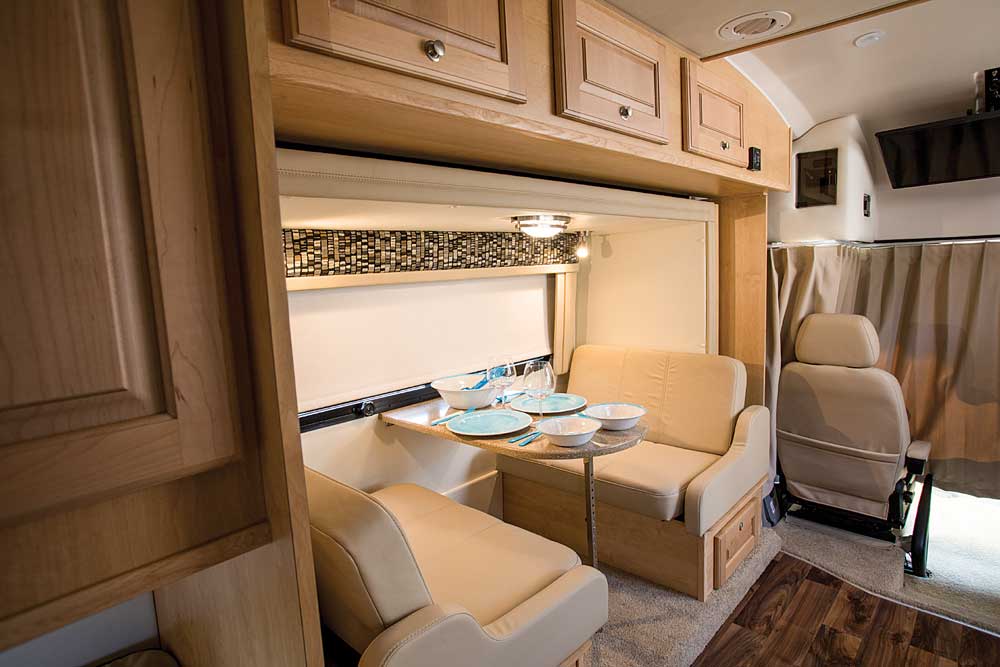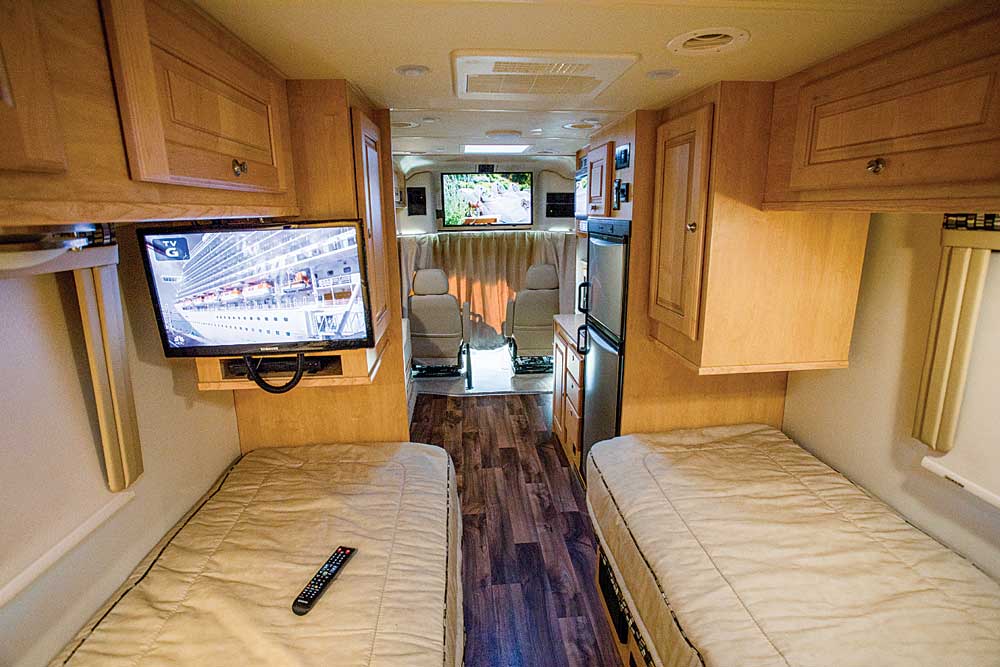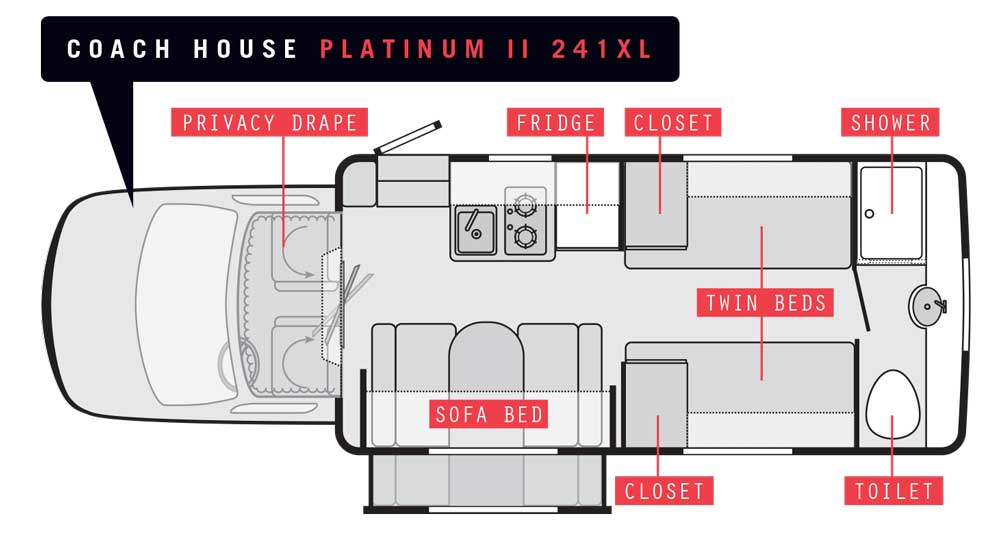Longtime factory-direct builder Coach House pulls out all the stops with its Platinum II 241XL touring motorhome designed for two
We’ve all seen commercials depicting how the rich and famous live on TV, the internet and in magazines. It’s fun to see a fat cat in a Ferrari, but in reality most of us will never experience that level of opulence. So why the infatuation with luxury that’s out of reach? People like to dream big, and when it comes to motorhomes, the focus on the luxury class is usually bus-style conversions or highline motorhomes built from the ground up. Even if price is no object, not everyone wants to tool around in a 45-foot coach just to attain top status. Coach House, a premium builder that sells only factory direct from its Nokomis, Florida, facility, has a different approach when it comes to manufacturing luxury motorhomes, and it does so in a compact package that’s easy to handle, attainable and missing none of the amenities discriminating owners crave. That shiny Mercedes-Benz emblem standing point on the Sprinter chassis grille is the first indication that this motorhome is at the higher end of the market, and when you step inside, the attention to details jumps out at you like a clown in a jack-in-the-box toy.
The Platinum II 241XL DT tested here is the company’s highest-level motorhome built on the Mercedes-Benz chassis and gets its designation based on a proprietary Premier body paint and slideout addition. The floorplan is one of many and in this model, a dinette and twin beds are the main focal points. Complementing the sleeping and dining arrangements are a nice-size rear bath and a galley that’s outfitted for a decent amount of prep work and cooking. While we’re not going to go out on a limb and label this motorhome as “diminutive,” it is definitely compact at just shy of 26 feet long, but it’s long on high-quality features commonly found in its highline brethren.

Dinette that seats two comfortably occupies the single slideout. The large window adds to the daytime ambiance.
Obviously, stepping up to the model with the slideout makes a huge difference in livability, and in this case there’s no compromise in handling and/or maneuverability. There’s no difference in exterior dimensions between the nonslideout 240 version and the 241XL test motorhome; just the footprint is larger when at an RV site.
 Clearly, this motorhome is designed for two people who can move about without being aisle hogs. The rear twin beds are stationary, a dinette in the slideout originating from behind the cockpit on the roadside is most comfortable for two and, of course, there are two seats in the driver’s compartment. In this plan, the bathroom spans the rear and offers surprising roominess, albeit only for one at a time, which is customary and expected. And there is no way to miss the effort that has gone into building this motorhome and the array of quality components that make it worthy of a higher-end sticker price.
Clearly, this motorhome is designed for two people who can move about without being aisle hogs. The rear twin beds are stationary, a dinette in the slideout originating from behind the cockpit on the roadside is most comfortable for two and, of course, there are two seats in the driver’s compartment. In this plan, the bathroom spans the rear and offers surprising roominess, albeit only for one at a time, which is customary and expected. And there is no way to miss the effort that has gone into building this motorhome and the array of quality components that make it worthy of a higher-end sticker price.
From the moment you enter the motorhome, the handsome, and not overstated, décor makes a statement that designers wanted to offer a rig that makes a great place to hang out in camp but also serves as a super comfortable touring vehicle. The nimble stature makes it practical for shopping-center and tourist excursions, but the nicely painted body and modern, smooth lines also make it at home in any RV park, including upscale resorts. We didn’t tow a dinghy vehicle during the test period and found tooling around city streets and congested highways perfectly acceptable. A hitch receiver does make it possible to tow a vehicle, within the limitations of the hardware and gross combination weight rating (gcwr).

The optional 23-inch smart TV is available for those who prefer not to view the main TV, and is mounted on a swing-down bracket for comfortable viewing from the bed area.
The versatility of a touring vehicle has some livability limitations, most of which have been circumvented in the Coach House by not overfurnishing the interior. Occupying about half the interior real estate is the upfront galley and opposing dinette. Both work well, but there is an element of acclimation needed to get into a routine. For one, it will take a few whacks on the head to figure out the low points created by overhead cabinetry, the slideout framing and the doorway. Once we made the concerted effort to prevent the head clunking, moving about went smoothly and without incident. Nevertheless, care must be taken when sliding into the dinette and leaving through the main door.

The bathroom is bigger than expected and is well-equipped with a porcelain toilet and quality fixtures.
Two people will have no problem hanging out on the dinette seats, and the table is large enough for mealtimes and for working on a computer, etc. When the cockpit seats are turned around, a smallish conversation area is formed, making it possible to entertain guests, and the fold-down, forward-mounted smart TV is clearly visible from the rear dinette seat; others will need to watch from the rear twin beds or stretch their necks for viewing. Cabinets above the table and below the seats are large enough to handle a good portion of kitchen supplies and foodstuffs, and the adjacent window occupies virtually the entire length of the slideout. An upholstered valance surrounds the MCD two-piece shades, also used throughout the motorhome.
Across the way, meals that are prepared at the galley will be less elaborate, but the essential appliances and cabinetry are provided. There are covers for the two-burner cooktop and compact sink and the large counter extension can be flipped up to provide more workspace. Open cubbyholes and drawers help control items that would otherwise clutter up the galley counter, especially one of this size. Heavy-duty cabinet hardware and soft-closing drawers are nice added touches that keep one from longing for a bigger rig. Adjacent is an extra-large (for the size motorhome) refrigerator. For on-the-road snacks and quick meals, the galley is perfect.

As mentioned earlier, entering and exiting the Coach House takes some finesse because of the limited height of the doorway. After a few head clunks, we managed to remember to duck; shorter people will have an easier learning curve. On the immediate right (behind the co-pilot’s seat) is a column-style cabinet structure that is control central. Here you’ll find the monitor panel for the holding tanks, the switch for the LP-gas/electric hot-water tank, the remote for the awning, switches for lighting and the battery cutoff control. There are also controls for the optional Equalizer Systems Stabi-Lite chassis stabilizers designed specifically for Class B and C motorhomes. It’s not a leveling system but is configured to take some of the rocking out of the chassis when parked with the slide extended. The system is made up of two jacks in the rear that are controlled by a one-touch switch. It adds $1,170 to the sticker price and is a worthwhile investment, as long as the user doesn’t expect too much.
 Occupants preferring twin beds will love this floorplan. The memory-foam mattresses are comfortable and long enough for all but 6-footers. While the mattresses measure 34 by 75 inches, after allowing for a little pillow room, the effective bed size shrinks somewhat. Tucking in a comforter takes some planning, and needs to be managed during the night’s sleep, but making the bed is relatively easy. Once in bed, effective LED lighting makes reading pleasant, and for those who want to watch the tube, an optional 23-inch smart TV is mounted at the foot of the streetside bed. Realistically, though, the front TV should do the job.
Occupants preferring twin beds will love this floorplan. The memory-foam mattresses are comfortable and long enough for all but 6-footers. While the mattresses measure 34 by 75 inches, after allowing for a little pillow room, the effective bed size shrinks somewhat. Tucking in a comforter takes some planning, and needs to be managed during the night’s sleep, but making the bed is relatively easy. Once in bed, effective LED lighting makes reading pleasant, and for those who want to watch the tube, an optional 23-inch smart TV is mounted at the foot of the streetside bed. Realistically, though, the front TV should do the job.
Above the beds are deep cabinets arranged symmetrically with additional storage capability under the streetside bed structure. Wardrobe closets at the foot of each bed will hold a good selection of clothing. Under the curbside bed are controls for the inverter and other electronic componentry. Large windows keep the area light and cheery, again covered by MCD shades, and two strategically placed Fan-Tastic Vent fans with rain sensors handle ventilation admirably.
The very rear of the motorhome is relegated to bathroom duties. On the left is a bigger-than-expected shower stall with a shelf that works great for holding body wash, shampoo and other necessities. Everyone will appreciate the utility of the shelf, but depending on how the motorhome is leveled, water may collect on the counter and need to be squeegeed off. And while the showerhead is pretty decent, the hose is way too short. When the showerhead is mounted on the hook, the hose gets in the way to move about freely. This, of course, is a very easy fix.
Physical dimensions predicate sink size, and the oval stainless-steel basin is just large enough to wash hands and brush teeth. As in the galley sink, the faucet is first-rate and not typical RV issue. Counterspace is expectedly small, but again, it gets the job done once an overall mindset is established. Cabinets above the sink are large enough for most of the essentials.
Tucked into the space created by the cabinet structure and wall of the bathroom (on the left side) is the porcelain toilet. Most people will be satisfied with this throne, but care must be taken to prevent head-banging when reaching down to flip up the toilet seat because of the protruding overhead cabinet. Also, the toilet-tissue holder should be relocated to a different wall as it restricts movement.
In true Coach House fashion, the door to the bathroom is solid and nice-looking. It can be latched open to keep from flinging about when on the road, but when in this position, it prevents access to the shower, but that’s no big deal. Most people will like the fact that this bathroom is bigger than expected for the size of the motorhome.
To reiterate, all the fixtures, hardware, woodwork and décor materials are first-rate. Everything is solid, including the Corian countertops and dining table. As a matter of fact, the dining table is almost too heavy to move, but that means it feels solid, which makes using it enjoyable. Along with these hefty items and other solid materials comes weight, and that’s where Coach House, or the customer, will have to make some adjustments. Once the water, LP-gas and diesel are added to the full marks, there’s only 370 pounds of payload left, most of which will be eaten up by the passengers, before loading with supplies. Some of that can be mitigated by running with only a few gallons in the water tank, but the motorhome will definitely need to be put on a diet.

Twin beds have foam mattresses that provide good support. Overhead cabinetry, wardrobes and drawers below hold plenty of supplies and clothing.
While the components that make up the motorhome contribute to the weight, the construction process is responsible for most of the heavy stature. Mated to the Sprinter chassis is a one-piece hand-laid fiberglass body reinforced with carbon fiber, a material that is lightweight, incredibly strong and durable. The proprietary shell is made to offer superior longevity and keep water and rattles out – and is patented. Everything about this motorhome exudes strength and good looks, especially after being treated to full-body paint.
Surprisingly, the short length and aerodynamic body allow for a generous assortment of exterior compartments. Good-size lockers are built on the right side, and a huge compartment occupies most of the rear. The rear compartment will likely be occupied by many of the larger items needed in an RV park; available space on the left side is filled by the LP-gas tank and generator. There’s also a door that leads to the small utility bay. Gracing the understated, and appreciated, graphics on the exterior is an armless electric patio awning and deep-tinted windows. A low-profile air conditioner, chrome wheel covers and cab steps round out the exterior accouterments.
Every motorhome that rolls off the assembly line receives the kind of attention only possible by a family-owned business like Coach House. The company’s latest lineup of high-end, compact motorhomes evolved beautifully from the first van conversion that rolled out of its Florida manufacturing plant in 1985. Today’s Coach House models are a far cry from the original van conversions, a testament to the family’s continued adherence to quality and build-it-right mantra. Personalized factory tours can be arranged, and a Buy-n-Fly program is offered to facilitate the procurement process.
Coach House Inc. | 800-235-0984 | www.coachhouserv.com

